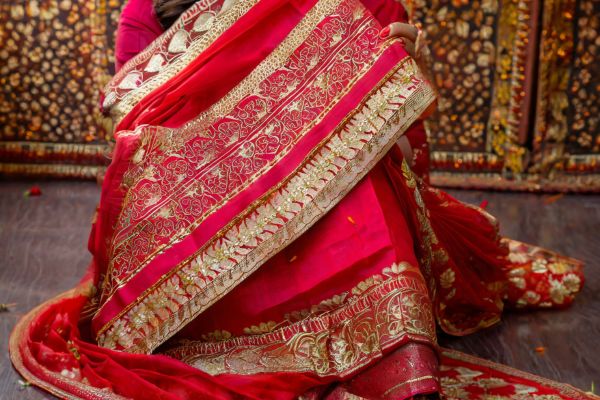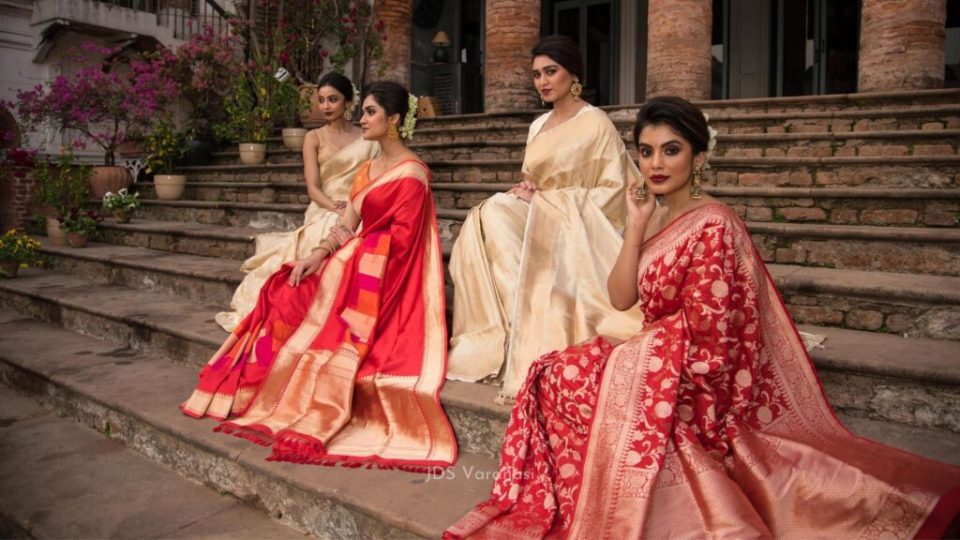Steeped in tradition and unmatched craftsmanship, the Banarasi saree has earned a place in the hearts of millions as a symbol of elegance, culture, and artistry. Hailing from the ancient city of Varanasi (Banaras), these sarees carry a legacy that spans centuries, narrating tales of exquisite weaving and meticulous artistry.
Historical Beginnings
The journey of the Banarasi saree can be traced back to the Mughal era, a time when Persian art and Indian traditions merged to create textiles of extraordinary beauty. Varanasi, a city revered for its cultural and spiritual significance, also became a hub for silk weaving under royal patronage. Historians suggest that the craft of weaving Banarasi silk sarees might have even earlier roots, with mentions in ancient Indian texts and scriptures describing the luxurious textiles of the region.
During the Mughal period, the artistry of Banarasi weavers reached its zenith. The use of gold and silver zari threads, along with intricate motifs inspired by Persian and Indian designs, made these sarees coveted across royal courts and beyond. This legacy of fine weaving and attention to detail continues to define Banarasi sarees today.
What Makes a Banarasi Saree Special?
Each saree is a masterpiece that can take weeks or even months to complete, depending on its complexity. Here’s what sets them apart:
- Rich Fabric: Crafted predominantly from pure silk, Banarasi sarees are known for their luxurious feel and sheen. Variants like Katan silk, georgette, and organza cater to different tastes while maintaining their hallmark quality.
- Intricate Designs: The beauty of a Banarasi silk saree lies in its detailed motifs. From paisleys and floral patterns to architectural designs and figurative art, these sarees showcase a diversity of patterns created using jacquard looms. Popular styles include the Jangla pattern, known for its sprawling floral vines, and the Brocade style, which features raised zari work.
- Zari Work: Zari, or metallic thread work, is a defining feature of Banarasi sarees. Traditionally made from pure gold or silver, the zari adds a regal touch to the saree, making it ideal for special occasions.
- Variety: Banarasi sarees come in different forms, catering to varied preferences. The pure silk Katan sarees are perfect for weddings, while lighter variants like georgette and shattir are versatile choices for other events.
Cultural and Traditional Significance
The Banarasi saree is more than just an attire; it’s an emblem of heritage and tradition.
- Weddings and Celebrations: In many Indian weddings, the bride’s trousseau is considered incomplete without a Banarasi saree. Its intricate designs and luxurious fabric symbolize prosperity and grace, making it a cherished heirloom passed down through generations.
- Religious Connection: Being crafted in one of India’s holiest cities, these sarees carry spiritual importance. They are often chosen for auspicious occasions and rituals.
- Symbol of Prestige: Owning a Banarasi saree is often seen as a mark of sophistication and timeless style. These sarees effortlessly blend tradition with grandeur, making them a favorite among women of all ages.
- Global Influence and Modern Appeal: Over the years, the Banarasi silk saree has transcended geographical boundaries, gaining admiration worldwide. During the colonial era, Banarasi textiles were exported to Europe, where their intricate patterns and luxurious texture found eager patrons.
Preservation Efforts

Despite its glory, the Banarasi saree industry faces challenges. Many traditional weavers struggle to sustain their craft due to the rise of machine-made replicas and fluctuating demand for handmade textiles.
To protect the authenticity of Banarasi sarees, they were awarded the Geographical Indication (GI) tag in 2009. This ensures that only sarees woven in Varanasi and its surrounding areas can be labeled as Banarasi sarees.
Government initiatives, non-profits, and fashion designers have also stepped up to revive and support the art. By promoting handwoven sarees and encouraging younger generations to learn the craft, these efforts aim to keep the legacy alive.
How to Identify an Authentic Banarasi Saree
For those seeking a genuine Banarasi saree, here are a few tips:
- Authentic Zari threads are made from pure silver and coated with gold. Cheaper versions may use plastic or synthetic materials.
- Handwoven Banarasi sarees have floats of thread on the reverse side of the fabric. This is a telltale sign of genuine craftsmanship.
- The density of silk and Zari used in an authentic Banarasi saree often makes it heavier than its machine-made counterparts.
- Purchasing from trusted outlets in Varanasi or certified sellers can help ensure authenticity.
A Legacy Worth Celebrating
The Banarasi saree is not just a piece of clothing but a celebration of India’s artistic heritage. Each weave tells a story of dedication, skill, and a tradition that has been nurtured for generations. For those looking to explore a stunning collection of Banarasi sarees, Taneira offers a curated selection, showcasing the finest handwoven sarees that embody both tradition and elegance.

